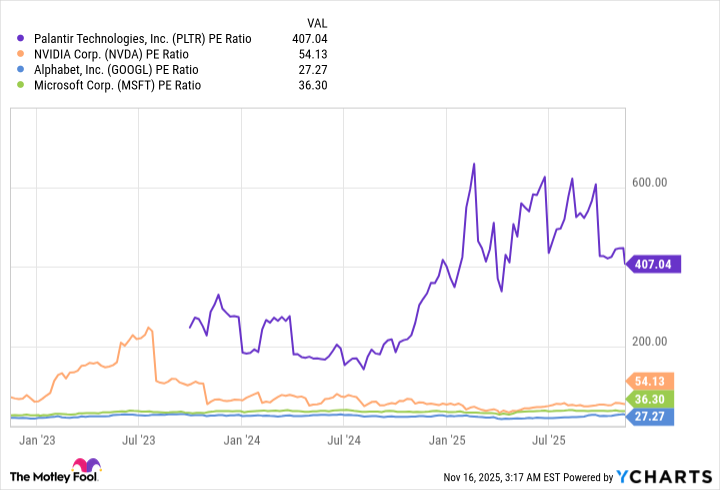A market cap of $1 trillion, while more common than it used to be, is still a major milestone. Only the 11 most valuable companies in the world have accomplished it so far.
At its current value, Palantir Technologies (PLTR 1.76%), an artificial intelligence (AI) data analytics company, doesn't look like it will join the trillion-dollar club in the near future. It's worth $410 billion (as of this writing), meaning it would need to more than double. However, Palantir stock has increased by nearly 2,000% in the last three years, so it's no stranger to big jumps.
Palantir has a little over three years to hit a $1 trillion valuation before 2030. Is it likely to get there? Let's find out.

Image source: Getty Images.
Business is booming for Palantir
Palantir develops data analytics software used by government agencies and corporations. Organizations use Palantir's services for insights into their data and data-backed decision-making. There's an incredibly wide variety of use cases, including national security, vaccine distribution, and inventory optimization, and about 1,500 companies reportedly work with Palantir.
It's a robust business, based on earnings reports from the last year-plus. Revenue has been climbing higher -- Palantir just generated $1.2 billion in the third quarter, a new record and a 63% year-over-year increase. In that quarter, it also closed a record $2.8 billion in total contract value, up 151% year over year.

NASDAQ: PLTR
Key Data Points
The company's biggest source of income is the U.S. government, with $486 million in Q3 revenue. In addition, U.S. commercial revenue in Q3 grew an impressive 121% year over year to $397 million. Overall, there's a lot to like about Palantir's finances. It makes money from government contracts and the private sector, it's rapidly increasing its earnings, and it has a great balance sheet with ample cash and without too much debt.
Palantir stock is extremely expensive
Palantir's earnings look good in a vacuum, but less so when you consider its massive market cap. Quarterly revenue of $1.2 billion isn't much for a company worth $410 billion. Currently, Palantir trades for 113 times trailing sales and a whopping 407 times trailing earnings.
Compared to other tech companies, including those that have surpassed $1 trillion, Palantir's valuation is very high. Nvidia, the largest company in the world, trades at 54 times trailing earnings. Microsoft and Alphabet are well below that. The chart below with trailing price-to-earnings (P/E) ratios over the past year demonstrates how much of an outlier Palantir is.
PLTR PE Ratio data by YCharts
To be fair, Palantir could find new ways to significantly ramp up revenue. It's an innovative company, and innovative companies are good at beating expectations. The risk is that Palantir will need to do that for its stock to keep rising. Lofty investor expectations are already priced in, and if it doesn't meet those expectations, the share price could take a hit.
$1 trillion before 2030 seems unlikely
Considering how much Palantir has grown over the last three years, reaching $1 trillion within the next three years might not seem like a huge stretch. However, growth is more difficult to come by the larger a company gets, and trading at over 400 times earnings isn't sustainable. At some point, Palantir will have a more reasonable valuation.
Let's say the market eventually values Palantir at about 50 times earnings -- in the same range as Nvidia right now. To be worth $1 trillion, it would then need $20 billion in net income. Over the trailing 12 months (TTM), Palantir has reported net income of $1.1 billion. Is going from $1.1 billion to $20 billion in three years possible? Sure. Is it likely? Definitely not.
The same is true about Palantir's odds of hitting $1 trillion before 2030. It's in the realm of possibility, but it's a long shot. The AI company could still do well without reaching that mark, of course. But the valuation makes it a high-risk, high-reward stock.
